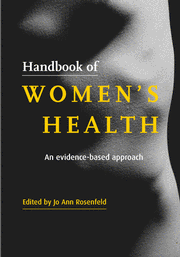Book contents
- Frontmatter
- Contents
- List of contributors
- Common abbreviations used in the text
- Normal blood values in women and during pregnancy
- Introduction
- 1 Singular health care of women
- Preventive care
- 2 Preventive care of adolescents
- 3 Preventive care of adults(19 to 65 years)
- 4 Preventive care for older adults
- 5 Cigarette smoking and cessation
- 6 Nutrition
- 7 Exercise
- Psychosocial health
- Sexuality
- Genitourinary medicine
- Breast disorders
- Psychological disorders
- Common medical problems
- Index
7 - Exercise
Published online by Cambridge University Press: 28 October 2009
- Frontmatter
- Contents
- List of contributors
- Common abbreviations used in the text
- Normal blood values in women and during pregnancy
- Introduction
- 1 Singular health care of women
- Preventive care
- 2 Preventive care of adolescents
- 3 Preventive care of adults(19 to 65 years)
- 4 Preventive care for older adults
- 5 Cigarette smoking and cessation
- 6 Nutrition
- 7 Exercise
- Psychosocial health
- Sexuality
- Genitourinary medicine
- Breast disorders
- Psychological disorders
- Common medical problems
- Index
Summary
The health benefits of exercise are well established. Mortality rates decrease as physical activity increases. Active people often outlive inactive people even when they begin exercise later in life.
Introduction
Aconsensus statement about the amount of exercise necessary to confer health benefits was published in Physical Activity and Health: A Report of the Surgeon General. The consensus states that children and adults should perform at least 30 minutes of moderate intensity activity almost daily. The activity can be divided into three or fewer parts.
The studies currently published are flawed in their abilities to accurately assess the physical activity of women. Nonetheless, regular sustained exercise is essential and the benefits far outweigh any risks. Many of the larger studies have been done on a predominantly male population; however, those studies including women tend to show comparable results on health.
Children and adults should perform at least 30 minutes of moderate intensity activity almost daily.
The benefits of exercise
Physiological
There are many beneits to regular exercise. The immediate physiological effects include stimulation of catecholamine, lowering in blood glucose levels, and improved sleep, both in quality and quantity.
Best reported benefits are the cardiovascular effects of exercise. Many retro
for exercising individuals. One of the largest studies to demonstrate the benefit of moderate as well as vigorous exercise is the Iowa Women's Health Study.6 Even nonstrenuous activity and walking have demonstrated reduction in risk for myocardial infarction (MI).
serum lipid levels are seen in individuals who exercise regularly. These include a reduction in serum triglyceride levels, elevations in HDL cholesterol and a decrease in LDL cholesterol.
…
- Type
- Chapter
- Information
- Handbook of Women's HealthAn Evidence-Based Approach, pp. 93 - 108Publisher: Cambridge University PressPrint publication year: 2001
- 1
- Cited by



